As the Inequality gap between the wealthy and poor grows, those who have fewer means must spend less on their children. Figure 2 depicts the growing spending gap between wealthier and poorer families. The top decile of household income has been able to spend more than twice the amount of money in 2010 on their children than the same group did in 1970, while the bottom decile of household income saw little or no increase in spending on children.
 (Figure 2)
(Figure 2)
Without as much income, parents in low-income households must spend more time working, and thus less time with their children. Furthermore, a smaller income inhibits the abilities of parents to spend on childcare services. Because individuals tend to be wealthier after receiving a college degree versus those with a high school diploma, Figure 3 shows the distinction in time spent with children based on education status. There is a clear difference in time spent with children, where more educated parents spend over 40 more minutes per day with their children. “About seven-in-ten (71%) parents with a bachelor’s degree say they read to their young children every day, compared with 47% of those with some college and 33% of those with a high school diploma or less” (Hughes). Although reading time spent with children is only one example of the distinction between the total time parents spend with their children based on social classes, it is indicative of American culture as a whole.
 (Figure 3)
(Figure 3)
This is a major problem because it inhibits the ability for children to become successful. Research has shown that the more interaction a child has with its parents or in childcare, the more likely she or he is to succeed in school, a precursor to later life success (Collie and Martin 1). Without the resources to provide children with this interaction, children born in poorer families are obstructed from later life success from the beginning.